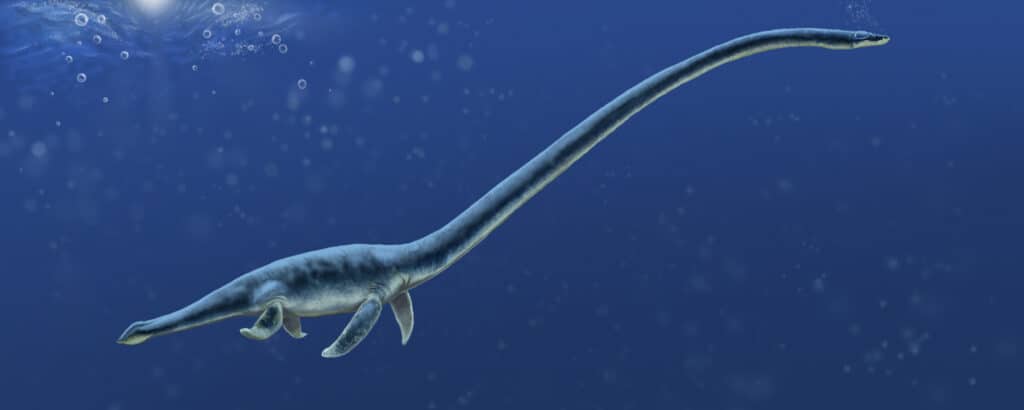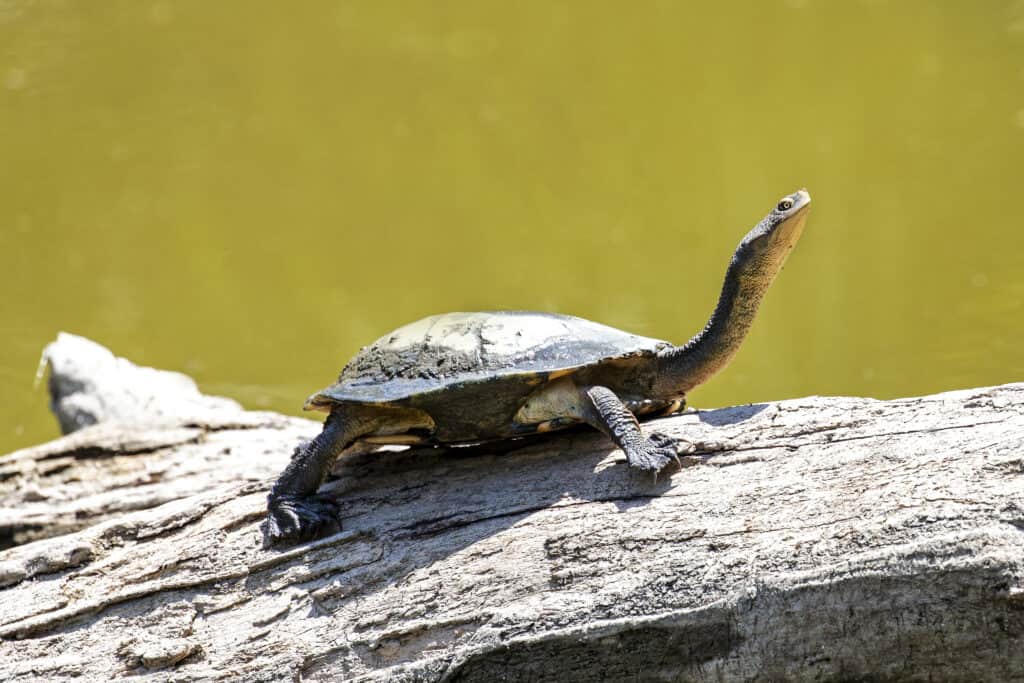There have been some large creatures on land, but when it comes to the ocean, they simply can’t compete! The sea has always been home to the scariest, deadliest, and largest predators in the world for millions and millions of years.
Few examples of this are better than one creature that lived 75 million years ago and has a neck so long, it puts giraffes to shame! Let’s discover the ancient sea predator with a massive 37-foot neck.
Albertonectes, One of the Longest Sea Predators to Have Ever Been Discovered

©Smokeybjb / Creative Commons Attribution-Share Alike 3.0 Unported license – License
When we talk about large predators, common examples like T-Rex or even Allosaurus are brought up. While these dinosaurs were large, they did have some limitations. In the ocean, though, there was a predator that had a neck as long as most other dinosaurs’ entire bodies: Albertonectes.
Albertonectes was an elasmosaurid plesiosaur from the Late Cretaceous period that was accidentally discovered during a gem mining expedition. Elasmosaurids were known for their extremely long necks, and Albertonectes had the longest of them all. As it stands, Albertonectes was probably the longest plesiosaur (a group of marine reptiles) to have ever lived.
The appearance of Albertonectes is similar to other marine dinosaurs that most people have seen before. Aside from the notably long neck, they had a round body with four short flippers, two on each side. For a pop-culture reference, Albertonectes would have looked like a thinner, longer version of the Loch Ness Monster.
The Size of Albertonectes
The dimensions of Albertonectes are so large they are almost comical. From the single fossil we have of the dino, scientists estimate that Albertonectes was around 38 to 40 feet long, with its neck making up around 23 feet of that length.
A standard-sized individual, around 36 feet long, would likely have weighed over 2 tons. The neck of Albertonectes contained 76 vertebrae, breaking the record for any other long-necked dinosaur in the elasmosaurid group. When compared to a giraffe, a creature with only seven cervical vertebrae, the true size of this long-necked creature is evident.
For reference, a standard school bus is around 35 feet. Imagining a sea dragon the size of a school bus chasing after you in the water is sure to put into perspective how crazy this sea creature was!
Where was Albertonectes Discovered?

©kavram/Shutterstock.com
There is only one fossil of Albertonectes that has ever been discovered. The fossil was found during a gem mining expedition south of the St. Mary River in southern Alberta, Canada. The miners were digging in ammonite shells when they stumbled across the fossil stuck in claystone. When they pulled it out, they had no idea that they had just found a record-setting dinosaur from millions of years ago.
Although only one fossil has been discovered, the specimen was so complete (very rare for ancient fossils) that much could be learned from the single find. Using scientific dating practices, it’s estimated that Albertonectes lived around 73.5 million years ago. Since the fossil was discovered in Alberta, Canada, the research team officially decided to name it Albertonectes, in the region’s honor. The second part of the name, “nectes,” means “swimmer” in Greek.
Why Did Albertonectes Have Such a Long Neck?

©iStock.com/Ken Griffiths
Although we don’t know exactly why so many marine elasmosaurids had long necks, one thing is clear: they probably weren’t flexible! When we picture Albertonectes or any other long-necked dinosaur, we usually envision a serpent-like creature with the ability to twirl, twist, and manipulate its head and neck like a snake. While that’s probably much scarier, it wasn’t the reality. Instead, these dinosaurs probably had rigid necks somewhat similar to a giraffe.
This is easily seen in the fossils of Albertonectes alone. When the creature died, it sank to the bottom and hit the ground. Instead of coiling up, however, the neck broke into multiple segments when the rest of Albertonectes‘s weight pressed down on it. Additionally, the space and mobility between the vertebra don’t allow for much movement. Despite being shown clips in movies and television of these dinosaurs swinging their heads around, it wasn’t the case in real life.
Still, there is some mystery as to why they had long necks in the first place. Without the high flexibility needed to catch squid and fish as they swam by, it doesn’t seem to make much sense.
Up Next
- Top 10 World’s Largest Dinosaurs Ever
- Meet Every Dinosaur Featured in Jurassic World Dominion (30 Total)
- The Largest Water Dinosaur in History
The photo featured at the top of this post is © Roland Tanglao from Vancouver, Canada / Creative Commons Attribution 2.0 Generic license – License / Original
Sources
- Wired, Available here: https://www.wired.com/2012/05/albertonectes-was-an-extreme-elasmosaur/
- National Geographic, Available here: https://www.nationalgeographic.com/science/article/albertonectes-was-an-extreme-elasmosaur
- Prehistoric Wildlife, Available here: http://www.prehistoric-wildlife.com/species/a/albertonectes.html
- T and F Online, Available here: https://www.tandfonline.com/doi/abs/10.1080/02724634.2012.658124
Thank you for reading! Have some feedback for us? Contact the AZ Animals editorial team.






